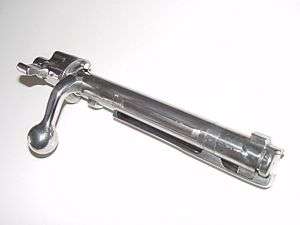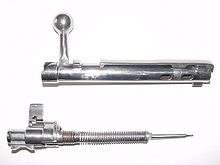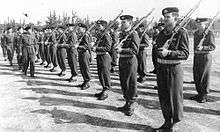Gewehr 98
| Gewehr 98 | |
|---|---|
|
Gewehr 98 made in 1898. From the collections of the Swedish Army Museum | |
| Type | Bolt-action rifle |
| Place of origin | German Empire |
| Service history | |
| In service | 1898–1945 |
| Used by | See users and civil users |
| Wars |
Boxer Rebellion, Herero and Namaqua Genocide,[1] Xinhai Revolution, Mexican Revolution, World War I, 1918 German Revolution, Finnish Civil War, Russian Civil War, Turkish War of Independence, Spanish Civil War, World War II, Second Sino-Japanese War, Chinese Civil War |
| Production history | |
| Designer | Paul Mauser |
| Designed | 1895 |
| Manufacturer | Mauser, Deutsche Waffen und Munitionsfabriken, Haenel, Sauer & Sohn, Waffenwerke Oberspree, V. Chr. Schilling Co., Simson, Imperial Arsenals of Amberg, Danzig, Erfurt, Leipzig, and Spandau |
| Produced | 1898–1918 |
| Number built | ~5,000,000[2] |
| Variants | K98a, K98b |
| Specifications | |
| Weight |
4.09 kg (9.0 lb) with empty magazine Gewehr 98 3.50 kg (7.7 lb) Karabiner 98a |
| Length |
1,250 mm (49.2 in) Gewehr 98 1,090 mm (42.9 in) Karabiner 98a |
| Barrel length |
740 mm (29.1 in) Gewehr 98 590 mm (23.2 in) Karabiner 98a |
|
| |
| Cartridge | M/88 until 1905, 7.92×57mm Mauser later |
| Action | Bolt action |
| Muzzle velocity | 878 m/s (2,881 ft/s) with 1905 pattern 9.9 g (154 gr) ball ammunition |
| Effective firing range |
500 m (550 yd) (with iron sights) ≥800 m (870 yd) (with optics) |
| Maximum firing range | 3,735 m (4,080 yd) with S Patrone |
| Feed system | 5 round stripper clips in an internal box magazine |
| Sights | Iron sights |
The Gewehr 98 (abbreviated G98, Gew 98 or M98) is a German bolt-action Mauser rifle firing cartridges from a 5-round internal clip-loaded magazine that was the German service rifle from 1898 to 1935, when it was replaced by the Karabiner 98k. The Gewehr 98 action, using stripper clip loading with the powerful 7.92×57mm Mauser cartridge, introduced advanced infantry weapon features rapidly adopted in the Anglo-American Pattern 1914 Enfield/M1917 Enfield and the Japanese Arisaka Type 38/Type 99. The Gewehr 98 replaced the earlier Gewehr 1888 rifle as the German service rifle, first saw combat in the Boxer Rebellion, and was the main German infantry rifle of World War I. The Gewehr 98 saw further military use by the Ottoman Empire and Nationalist Spain. Many have been converted to sporting use.
History

The Gewehr 98, named for 1898, the first year of its manufacture, superseded the earlier Gewehr 1888 in German service. The bolt-action design used for the Gewehr 98 was patented by Paul Mauser on 9 September 1895. The Gewehr 98 itself was the latest in a line of Mauser rifles that were introduced in the 1890s.
The German Gewehr-Prüfungskommission (G.P.K.) (Rifle Testing Commission) adopted the Gewehr 98 on 5 April 1898. The action was derived from the experimental Gewehr 96 Rifle. In 1901, the first troop issues of the Gewehr 98 Rifles were made to the East Asian Expeditionary Force, the Navy and three premier Prussian army corps. The first combat use of the Gewehr 98 was during the Boxer Rebellion (1898–1901). In 1904, contracts were placed with Waffenfabrik Mauser for 290,000 rifles and Deutsche Waffen und Munitionsfabriken (DWM) for 210,000 rifles.
In 1903, the 8 mm M/88 cartridge which was introduced in 1888 and loaded with an 8.08 mm (.318 in) 14.6 g (226 gr) round nose bullet was replaced by the 7.92×57mm Mauser S Patrone (S ball cartridge) which was loaded with a new 8.20 mm (.323 in) 9.9 g (154 gr) spitzer bullet. The ammunition conversion was indicated by a small "S" stamped above the chamber and on the barrel at the back of the rear sight base. This was done since the 1888 pattern M/88 cartridge and 1903 S-bore pattern cartridge are two different non interchangeable chamberings. Since the new IS cartridge had a flatter trajectory the Lange Visier rear sight had to be changed with an "S"-adapted Lange Visier.
Design details
The Gewehr 98 or model 98 (M98) rifle is a manually operated, magazine fed, controlled-feed bolt-action rifle, 1,250 mm (49 in) in length and 4.09 kg (9 lb) in weight. It has a 740 mm (29 in) long rifled barrel and carries 5 rounds ammunition in an internal magazine. The Gewehr 98 has two sling swivels, open front sights, and a curved tangent-type rear sight, known as the Lange Visier.
The controlled-feed bolt-action of the Gewehr 98 is a distinct feature and is regarded as one of the major bolt-action system designs.
M98 controlled-feed bolt-action system



The controlled-feed Mauser M98 bolt-action system is a simple, strong, safe, and well-thought-out design intended to negate as many failure modes as possible that inspired other military and hunting/sporting rifle designs that became available during the 20th century. A drawback of the M98 system is that it cannot be cheaply mass-produced very easily. Some other bolt-action designs (e.g. the Lee–Enfield) offer trained operators a faster rate of fire.
Features
The M98 system[3] consists of a receiver that serves as the system's shroud and a bolt group of which the bolt body has three locking lugs, two large main lugs at the bolt head and a third safety lug at the rear of the bolt, which serves as a backup in case the primary locking lugs failed. This third lug is a distinctive feature and was not present on previous Mauser bolt action designs. The two main locking lugs are positioned opposed to each other and display a locking surface of 56 mm2 (0.087 in2), whilst the third safety lug normally plays no part in locking the action to avoid asymmetric and hence unbalanced bolt thrust forces.[4] The diameter of the M98 system receiver ring was also enlarged to 35.8 mm (1.41 in) diameter compared to previous Mauser "small ring" bolt action designs that had 33 mm (1.30 in) diameter receiver rings for additional strength and safety. Accordingly, the barrel shank was enlarged to 28 mm (1.10 in) diameter with 15.88 mm (0.625 in) of threaded area at 12 threads per inch compared to previous Mauser "small shank" bolt action designs that had 24.9 mm (0.98 in) diameter with 16.38 mm (0.645 in) of threaded area at 12 threads per inch barrel shanks for additional strength. The bolt handle is permanently attached to the bolt and, on the Gewehr 98, is straight and protrudes out for optimal leverage.
Another distinctive feature of the M98 system is the controlled-feed mechanism, consisting of a large, non-rotating claw extractor that engages the cartridge case rim as soon as the round leaves the magazine and firmly holds the cartridge case until the round is ejected by the ejector, mounted inside the receiver. Combined with a slight bolt retraction at the last stage of the bolt opening cycle, caused by the cammed surface on the rear receiver bridge, this results in a positive cartridge case extraction. The M98 bolt-action will cycle correctly, irrespective of the way the rifle is moved or positioned during the bolt cycling action or if the cartridge has been fired or not. Only if the bolt is not brought back far enough, sharply enough, in a controlled round feed bolt-action the cartridge case may not be cleanly ejected and a jam may result.
The bolt houses the firing pin mechanism that cocks when the bolt is opened, and the cocking piece protrudes visually and tactilely from the rear of the bolt to indicate the action is cocked. A cocking shroud lock that was not present on previous Mauser bolt-action designs was added. The distance the firing pin needs to travel was decreased to reduce and hence improve lock time — the amount of time between initiating the firing sequence by releasing the trigger and the firing pin striking the primer that ignites the propellant contained in the 7.92×57mm Mauser cartridge.
The action features two large oval shaped gas relief holes and a gas shield on the bolt sleeve designed to protect the users head in case of a primer or cartridge rupture or detonation. When the action suffers a catastrophic failure, these safety features deflect escaping gas and eventual debris away from the operator's face.
The M98 bolt group can be easily removed from the receiver simply by rotating the safety lever to the 12 o'clock position and pulling out the bolt stop lever, located at the rear left wall of the receiver, and then operate the action and continue rearward bolt travel past the bolt stop. The metal disc inlay in the stock functions as a bolt disassembly tool.[5]
Many metal parts of the Gewehr 98 were blued, a process in which steel is partially protected against rust by a layer of magnetite (Fe3O4). Such a thin black oxide layer provides minimal protection against rust or corrosion, unless also treated with a water-displacing oil to reduce wetting and galvanic corrosion. From 1905 until 1945 the German military used Ballistol intended for cleaning, lubricating, and protecting metallic, wooden and leather firearms parts.[6]
Safety
A three-position safety attached at the rear of the bolt which operating lever can be flicked from right (safety on, bolt locked) to middle (safety on, bolt can be opened for reloading), to left (ready to fire), but only when the rifle is cocked; otherwise, the safety will not move. The safety secures the firing pin. The safety catch lever is quite large, making it easy to operate, but posing a problem for mounting telescopic sights low above the receiver whilst retaining good operability of the safety catch lever.
Ammunition feeding
The internal magazine of the M98 system consists of an integral box machined to match the cartridge for which the rifle was being chambered, with a detachable floorplate, that can hold up to 5 rifle cartridges. The German military M98 system internal magazine boxes feature an internal magazine length of 84 mm (3.31 in) to store 82 mm (3.23 in) maximal overall length 7.92×57mm Mauser cartridges without dimensional issues. The cartridges are stored in the magazine box in a staggered column at a stacking angle of 30 degrees, so viewed from the end, three cartridges touching each other form the points of an equilateral triangle. The magazine can be loaded with single rounds by pushing the cartridges into the receiver top opening or via stripper clips. Each stripper clip can hold 5 rounds to fill the magazine and is inserted into clip guides machined into the rear receiver bridge. After loading, the empty clip is ejected when the bolt is closed. The magazine can be unloaded by operating the bolt (the safety should, for safety reasons, be set to the middle position for this) or, in case of mechanical problems, by opening the magazine floorplate, which is flush with the stock, with the help of a cartridge tip. Alternatively cartridges can be loaded singly directly into the chamber, as is standard on military rifles of the period, since the extractor is spring-loaded and designed so the extractor claw "pops" over the rim of the cartridge on closing.
The Gewehr 98 had no magazine cut-off mechanism, which when engaged permits the feeding and extraction of single cartridges only while keeping the cartridges in the magazine in reserve. Like the M98 system Mauser magazine fed bolt-action systems were generally not manufactured with magazine cut-offs, the Ottoman Mauser variant being the exception.[7]
Modern civilian offspring of the M98 system
Though the production of the M98 system for the German military ceased at the end of World War II in 1945, the production of new Mauser M 98 and Mauser M 98 Magnum rifles for civil users has been resumed in 1999 by Mauser Jagdwaffen GmbH[8] (Mauser Huntingweapons Ltd.), according to original drawings of 1936 and the respective Mauser patents. These rifles retail (2009) for approximately EUR 6,800 for the basic Mauser M 98 version, but the addition of (luxury) options can make these rifles much more expensive. Several other gun manufactures and custom gun builders also currently produce new M98 system clones or M98 inspired bolt-action hunting/sporting rifles. Many Mauser M98 inspired derivatives feature technical alterations to simplify production.
Trigger
The rifle had a two-stage trigger with considerable take up before the trigger engages the sear. This feature aids in preventing premature firing during stressful (combat) situations.
Sights
Originally the Gewehr 98 sight line had an open post type front sight, and a curved tangent-type rear sight with a V-shaped rear notch, known as the Lange Visier (Lange sight after its designer Lieutenant Colonel Lange). The rear sight was graduated for 1888 pattern M/88 cartridges from 200 m (220 yd) to 2,000 m (2,200 yd) in 100 m (110 yd) increments. The M/88 cartridge was loaded with full metal jacket projectiles of the round-nosed type.
The standard open iron sight aiming elements consisted of relatively coarse rugged aiming elements making the sightline suitable for rough handling and low light usage, but less suitable for aiming at small point targets. The tracks of the rear sight obstructed the view to the sides during aiming. The sights were designed with distant area fire targets like charging horseman units in mind, so the standard iron sight line could be calibrated for very long ranges. Military doctrine in the late 19th and early 20th century considered firing at distant area targets, where an officer would call out the range and the soldiers shot in volley, normal.
German government driven efforts to improve the performance of the military M/88 ammunition and the service arms in which the M/88 was used resulted in the design by the Gewehr-Prüfungskommission and adaptation in 1903 of the dimensionally redesigned 7.92×57mm Mauser chambering. Besides the chambering, the bore (designated as "S-bore") was also dimensionally redesigned. The 1903 pattern 7.92×57mm Mauser S Patrone (S ball cartridge) was loaded with a lighter 9.9 grams (153 gr), pointed Spitzgeschoß (spitzer bullet) of 8.2 mm (0.323 in) diameter and more powerful double-base (based on nitrocellulose and nitroglycerin) smokeless powder. With the improved ballistic coefficient of the new spitzer bullet, the 1903 pattern cartridge had an improved maximum effective range and a flatter trajectory, and was therefore less critical of range estimation compared to the M/88 cartridge.[9] With the introduction of the S Patrone the rear sight graduation was changed accordingly and could be regulated from 400 m (440 yd) to 2,000 m (2,200 yd) in 100 m (110 yd) increments.
Interestingly, while the modified sight line for 1903 pattern 7.92×57mm Mauser S Patrone IS cartridges was calibrated for a minimal zero distance of 400 m (440 yd) and can result in hitting high when using the open post front sight and V-shaped rear notch at close range, the pillars formed by the tracks of the rear sight allow closer targets to be quickly bracketed between the "goalposts", a sighting method that automatically compensates for the high point of aim using the normal sighting method at sub-400 m (440 yd) ranges.
Stock
The Gewehr 98 oil finished rifle stock features a semi-pistol grip. A top handguard was standard on all rifles and extended from the front of the rear sight base terminating just ahead of the bottom barrel band. A steel cross bolt was mounted to distribute the forces and hence the effects of recoil on the stock bedding, reducing the chance to split the stock. The stock featured a quick detachable sling swivel on the underside of the butt stock, a top swivel located underneath the bottom barrel band, and a parade hook mounted on the underside of the top H-style barrel band. The prewar stocks were produced from walnut wood and were aged for an average of three years to allow the wood to stabilize. Beginning in 1917, walnut shortages necessitated the use of beech wood. The late-war production beech stocks were less durable and heavier than the original walnut stocks.
Accessories
The rifle was issued with a leather carrying sling. During the duration of World War I, due to a shortage of leather, slings were produced out of canvas.
The rifle was able to fire rifle grenades. Various attachable rifle grenade launcher models were designed during World War I.
The Gewehr 98 was designed to be used with a bayonet.[10] For this the rifle had a H-style top barrel-band with a 4.5 cm (1.8 in) long bayonet lug. The long bearing surface on the Gewehr 98 eliminated the addition of a muzzle ring. The advantage of this solution lies in the fact that muzzle rings can interfere with barrel oscillation which can significantly impede the accuracy of a rifle. The rifle was originally issued with the Seitengewehr 98 pattern bayonet. This épée style bayonet has a 500 mm (19.7 in) long quillback blade. By the end of 1905, this bayonet began to be replaced with the more robust and practical Seitengewehr 98/05, with a 370 mm (14.6 in) blade. It was called the "Butcher Blade" by the Allies due to its distinctive shape, and was initially intended for artillerymen and engineers as a chopping tool as well as a weapon. Towards the end of World War I, the 250 mm (9.8 in) blade Seitengewehr 84/98 was introduced as an economy measure and because the longer models were impractical in narrow trenches; this model became standard issue during the Weimar Republic and Third Reich. Serrated, saw-backed versions of the standard patterns intended to be used as tools were carried by German Pioniere (pioneers).
Variants
Sniper models
In the spring of 1915, it was decided to fit 15,000 Gewehr 98 rifles, selected for being exceptionally accurate during factory tests, with telescopic sights for sniper use, though the Gewehr 98 was not designed for use with aiming optics. To mount a telescopic sight directly over the rifle, the bolt handle had to be turned-down from its original straight design. In the stock, a recess had to be made to accommodate the turned-down bolt handle modification. The telescopic sights consisted of 2.5× and 3× models, made by manufactures like Görtz, Gérard, Oige, Zeiss, Hensoldt, Voigtländer and various civilian models from manufacturers like Bock, Busch and Füss. Several different mountings produced by various manufacturers were used. Even with a turned-down bolt handle (unless it is low-profile as is common practice with modern hunting rifles), optics mounted low above the receiver will not leave enough space between the rifle and the telescopic sight body for unimpaired operation of the bolt or three-position safety catch lever. This ergonomic problem was solved by mounting the telescopic sight relatively high above the receiver. By the end of the war, 18,421 Gewehr 98 rifles were converted and equipped with telescopic sights and issued to German snipers during World War I.[2][11]
Karabiner 98a

Not to be confused with the later Karabiner 98k or earlier Karabiner 98A (uppercase A), the Karabiner 98a (K98a) was a shorter version of the Gewehr 98 originally made for cavalry and support unit use. The original model Karabiner 98, with a shorter barrel than the G98, was produced from 1899–1908, but it was not successful. In 1908, the Karabiner Model 1898AZ was approved. The "AZ" stands for "Aufpflanz-und-Zusammensetzvorrichtung".[12] The new features were a small diameter receiver ring, tapered rather than stepped barrel contour, an L-shaped stacking rod attached to the stock near the muzzle, a turned-down bolt handle and recess in the stock in the same fashion as sniper Gewehr 98s. The "A" stood for "with bayonet", the "Z" stood for stacking pyramid, meaning carbine Model 1898 with bayonet attachment point and stacking rod device. In 1923, the AZ was dropped for 'a' as Germany sought to distinguish the model from the newer models 'b' and 'k'.[13]
During World War I, the Karabiner 98a was issued to cavalry, to mountain troops, and later to assault troops. It was liked because it was lighter and shorter than the Gewehr 98, and was thus better suited for use in trench assaults.
Karabiner 98b
The Karabiner 98b was not technically another "carbine" variant, but rather was a rifle designated as a carbine to comply with the terms of the Treaty of Versailles which only allowed Germany to produce carbines.[13] The Karabiner Model 1898b was introduced in 1923.[14] The 98B had a tangent rear sight as opposed to the original "Lange" ramp sight, a wider lower band with side sling attachment bar, a side butt attachment point for a sling, and a turned down bolt handle. It was otherwise merely a modified form of the Gewehr 98, from which the Karabiner 98k was derived.
Combat service
The Gewehr 98 saw service primarily in World War I, as well as various colonial actions in the preceding years. As with all contemporary bolt-action rifles, it was a powerful and accurate rifle with long range that was poorly suited for the close quarter fighting of trench warfare. The considerable length of the rifle and the minimum sight setting of 400 meters (far in excess of the typical range in trench battles) were particular handicaps.
Its successor, the Karabiner 98k, would go on to be the standard rifle of the German infantry during World War II. Some Gewehr 98s also saw service in World War II, though many of these older rifles were converted to either 98b or 98k specifications.
The Gewehr 98 after World War I
Sporting and hunting
M 98
The Mauser M 98 was a civilian version adapted for hunting and other sporting purposes of the Gewehr 98 service rifle. Vaguely similar to the latter rifle in appearance, the M 98 was offered in many different hunting chamberings, not like the original service rifle. The Mauser M 98 series offered several features and factory options, that are also typical for sporterised ex-service rifles, ranging from various technical departures from the basic Mauser service rifle it was based on to luxury wood grades, (gold) inlays, engravings and surface treatments like color case hardening. Some of the available options were originally developed and introduced by John Rigby & Co. on Rigby Mauser hunting rifles.
M 98 magnum
John Rigby & Co. commissioned Mauser to develop the M 98 magnum action in the early 1900s. It was designed to function with the large sized cartridges normally used to hunt Big Five game and other dangerous game species. For this specialized type of hunting, where absolute reliability of the rifle under adverse conditions is very important, the controlled-feed M 98 system remains the standard by which other action designs are judged.[15] In 1911 John Rigby & Co. introduced the .416 Rigby cartridge that due to its dimensions could only be used in the M 98 magnum action.[16]
Rechambered rifles
After World War I, the Treaty of Versailles left Germany extremely constricted in terms of military power. Civilians were not allowed to have any use of standard military weapons or ammunition. Since the 7.92×57mm Mauser round was so stout and great for hunting, people did not want to give up on it, so a redesign of the cartridge was made for the civilian market resulting in the 8×60mm S featuring a new longer case. The 8×60mm S cartridge was kept under 84.4 mm (3.32 in) overall length to fit the cartridge in standard military M98 magazine boxes without any modification.
The also rare 8×64mm S cartridge offers a comparable rechambering option for Mauser Gewehr 98 and Karabiner 98k rifles sporting 8mm S-bores. Due to its larger case capacity the 8×64mm S chambering offers better ballistic performance than the 8×60mm S. Some custom rifles were made using Mauser 98's and rechambering them for the 9×57mm Mauser.
Since the purpose for these rifles was hunting and sporting, the bolt handle was professionally bent down, gradually the bent bolt handle became the standard and replaced the older straight style (though that was of course not always the case). The standard military sights were replaced by a 100 m sight, along with a flip-up on the rear sight for 200 m. The military stocks were replaced by newer ones that did not include the extra length of stock needed for the bayonet lug.
Today these sporter rifles are extremely rare and the 8×60mm S, 8×64mm S and 9×57mm Mauser cartridges are nearly obsolete, as only few mainstream ammunition manufacturers along with some other smaller companies continue to produce them. When correct ammunition is used in a converted rifle, an 8×60mm S, 8×64mm S or 9×57mm Mauser modified Gewehr 98 can be an extremely potent and inexpensive long-range big-game rifle.
Also, many Gewehr 98 rifles acquired as trophies by Allied forces during the war and brought to the US were converted to the 8mm-06 wildcat cartridge, a modification of the original 8×57mm IS chambering to 8×63mm S to accommodate the use of the plentiful .30-06 Springfield brass for reloading, with 8mm (.323 caliber) bullets. Such conversions are indistinguishable from unmodified rifle without careful examination, and can be quite dangerous if fired with the shorter 8×57mm ammunition, as the cartridge case will stretch to fit the elongated chamber and possibly rupture in the process, which causes a potentially highly dangerous high pressure propellant gas leakage. However, the Mauser M 98 action is designed specifically to direct gas away from the shooter in the event of a case rupture.
In the 21st century the US based company Rhineland Arms started to produce .45 ACP conversion kits for the Mauser action using M1911 pistol magazines.[17]
Shotgun conversions
Many were converted to shotguns, typically in 12 and 16-gauge, as well as a few in 20-gauge. In making the conversion, both main locking lugs were typically removed. The magazine was altered to allow a single shell in reserve. Many authorities recommend against firing these guns, particularly with modern magnum shotshells.[18][19]
Weimar Republic and Nazi Germany
The Weimar Republic, the successor state to the German Empire, implemented a program designed to update their remaining supplies of Gewehr 98 rifles for the Reichswehr in the years following World War I. Rifles allowed into service with the early Weimar security forces were stamped with a "1920" marking on their receiver ring. Further updates to Weimar-era Gewehr 98's often included the replacement of the Lange Visier rear sight with a standard Karabiner 98k-style rear sight, a hole cut through the side of the stock to accommodate a Karabiner 98k-style side mounted sling system and sometimes a shortening of the barrel to Karabiner 98k length. Many were also given a turned-down bolt handle, replacing the original straight bolt handle style. Rifles that received these later modifications will often have both Weimar-era and Nazi markings, and "S/42" stamped on the rear sight base. Some of these rifles saw use in World War II but mostly in second line units because the shortened and improved Karabiner 98k was the standard issue rifle by that time. Gewehr 98s were also sometimes stripped for their receivers and Karabiner 98k rifles were built on those receivers. Some German police officers were seen using Gewehr 98s as the Allies entered Germany in the final months of the war.
Additionally, Adolf Hitler initially chose to outfit his elite Schutzstaffel (SS) bodyguard units with modified Gewehr 98 rifles. Those rifles obtained by the SS normally had their original markings fully or partially removed and replaced with stylized Totenkopf markings.
The Volkssturm ("People's Militia") also made use of the Gewehr 98, out of all their mixed arsenal the Gewehr 98 was probably the best since it used standard 7.92×57mm IS rounds and a man trained on a Karabiner 98k could transition over to the Gewehr 98 easily since the actions of both rifles were the same.
Ottoman Empire
Large numbers of Gewehr 98 rifles were also given to the Ottoman Empire both during and after World War I, including the majority of 1916 Waffenfabrik Oberndorf production. Many of these rifles were converted to the "M38" standard by the Republic of Turkey in the years before, during, and after World War II. Today these rifles are widely available in North America along with other Turkish Mausers. Careful observation is usually needed to tell an ex-Gewehr 98 apart from the myriad of other common M38-standard Mausers. Turkish Gewehr 98 rifles that were not converted can be easily identified by a crescent moon stamping on the top of the receiver.
Czechoslovakia
After Czechoslovakia was founded in 1918, they bought several Gewehr 98 rifles for their military.
Spanish Civil War
The rifle saw some usage in the Spanish Civil War, mostly in the hands of Generalissimo Franco's Nationalists and German volunteer legions. Most of these rifles were bought and exported to the United States as cheap sporting rifles in the 1960s by Interarmco.
Israel

During the formation of the state of Israel in the aftermath of World War II, the Haganah acquired substantial numbers of Karabiner 98k rifles from any European sources they could find. Some of these rifles were converted Gewehr 98 rifles, which aside from the Imperial German markings are identical to all other Israeli Mausers. Like other Israeli Mausers, most of these rifles were rebarreled for 7.62×51mm NATO after that round was adopted as the Israeli standard in 1958.
Jubiläum 98 model (1998)
In 1998 the Mauser works at Oberndorf produced the Jubiläum 98 (Anniversary 98) model, a fully functioning replica of the original Gewehr 98, to celebrate the rifle's centenary year. 1998 rifles were produced.
Non-German Gewehr 98 derivatives
Many non-German military service rifles and carbines were derived from and/or based on the Mauser M98 bolt-action system. Some of these were German-made by various contractors other than Mauser:[20]
- M1902, M1912, M1924 & M1936 Mexican in 7×57mm Mauser
- M1903 Turkish in 7.65×53mm Argentine
- M1903 Springfield .30-06 Springfield, United States of America
- M1904 & M1912 Chilean in 7×57mm Mauser
- M1912 Colombian in 7×57mm Mauser
- M1904 Portuguese in 6.5×58mm Vergueiro, 7×57mm Mauser and 7.92×57mm Mauser
- M1908 Brazilian in 7×57mm Mauser
- M1909 Argentine in 7.65×53mm Argentine
- M1910 Serbian in 7×57mm Mauser
- Pattern 1914 Enfield British in .303 British
- M1917 Enfield American in .30-06 Springfield
Following the collapse of the German Empire after World War I, many countries that were using Mauser models chose to develop, assemble, or modify their own rifle designs that were derived from and/or based on the Mauser M98 bolt-action:
- vz. 98/22 Often made from Gewehr 98 parts, rebuilt in the BRNO factory in Czechoslovakia.
- M1924 type Zhongzheng rifle Chinese in 7.92×57mm Mauser
- vz. 24 Czechoslovakia in 7.92×57mm Mauser, 7×57mm Mauser and 7.65×53mm Argentine
- vz. 33 Czechoslovakia in 7.92×57mm Mauser
- M1924 and M1930 made by the Belgian Fabrique Nationale
- Karabinek wz. 1929 Polish in 7.92×57mm Mauser
- Kb wz. 98a Polish in 7.92×57mm Mauser
- M1943 Spanish short (not to be confused with the M93 Spanish Mauser) in 7.92×57mm Mauser manufactured in the Spanish arsenals. Will have "La Coruna" or the Spanish Air Force Eagle stamped on the top of the receiver. Virtually identical to the Karabiner 98k.
After World War II the Mauser M98 bolt-action system was used by Yugoslavia to design the Zastava M48 and Spain to design the FR8.
Users
 Argentina: 200.000 units bought in its Mauser 1909 variant form.[21]
Argentina: 200.000 units bought in its Mauser 1909 variant form.[21].svg.png) Belgium[22]
Belgium[22] Czechoslovakia[22]
Czechoslovakia[22] German Empire[23]
German Empire[23].svg.png) Weimar Republic[24]
Weimar Republic[24].svg.png) Nazi Germany[25][26][27]
Nazi Germany[25][26][27] Mexico[28]
Mexico[28] Ottoman Empire[29]
Ottoman Empire[29] Peru[28]
Peru[28] Poland: Made in Państwowa Fabryka Karabinów in Warsaw and Fabryka Broni in Radom[30]
Poland: Made in Państwowa Fabryka Karabinów in Warsaw and Fabryka Broni in Radom[30] Republic of China: in the form of the Chiang Kai-shek rifle.[31]
Republic of China: in the form of the Chiang Kai-shek rifle.[31].svg.png) Spain[32]
Spain[32] Kingdom of Yugoslavia[33]
Kingdom of Yugoslavia[33] Ireland used by the Irish Republican Army during the Irish Civil War
Ireland used by the Irish Republican Army during the Irish Civil War
See also
- List of infantry weapons of World War I
- Karabiner 98k German 1930s successor
References
- ↑ Walter Nuhn: Sturm über Südwest. Bernard & Graefe, 2007, ISBN 3-7637-6273-6 (German)
- 1 2 "French Gewehr 98 and Karabiner 98a". Tirmilitairefabrice.ifrance.com. Retrieved 6 May 2011.
- ↑ "Exploded view drawing of the Mauser Model 98 controlled-feed bolt-action". Retrieved 6 May 2011.
- ↑ Blaser R8 Repetierbüchse(German)
- ↑ https://www.youtube.com/watch?v=2A_-FnDhmAc
- ↑ Ballistol about us
- ↑ Ottoman Mauser Model of 1893 - Magazine Cut-Off
- ↑ "Mauser Jagdwaffen GmbH". Mauserwaffen.de. Retrieved 6 May 2011.
- ↑ The 8 mm (7,92×57) Mauser Cartridge
- ↑ "The Model 1898 infanterie Gewehr: the German 98 Mauser was blooded and proven during the four nightmare years of WWI". Findarticles.com. Retrieved 6 May 2011.
- ↑ Übe Auge und Hand fürs Vaterland, Die Waffen der Deutsche Jäger und Scharfschützen, Teil 3 (German)
- ↑ German Military Rifles and Machine Pistols 1871-1945, Hans Dieter Gotz, Schiffer publishing 1990, Motorbuch Verlag, Stuttgart, ISBN 3-87943-350-X, page 148
- 1 2 Smith, Randy D. (2005). "Old Mausers". Retrieved 1 April 2007.
- ↑ Graf (2005). "The Kar.98a". Retrieved 1 April 2007.
- ↑ John Rigby & Co. - Rigby African Express Bolt Rifle
- ↑ van Wyk, Johan (October–November 2007). "Mr Rigby and the Mauser". African Outfitter. 2/6. Retrieved 19 May 2011.
- ↑ Holt Bodinson (April 2005), "Rhineland .45 ACP Carbine: fun conversions for surplus Enfields and Mausers", Guns Magazine
- ↑ Holt Bodinson (May 2008), "Mauser 98 shotgun: an interesting Mauser collectible", Guns Magazine
- ↑ Frank De Haas, Wayne Zwoll. Bolt Action Rifles. pp. 334–337. ISBN 0-87349-660-4.
- ↑ Johnson, Melvin M., Jr. (1944). Rifles and Machine Guns. New York: William Morrow & Company. p. 89.
- ↑ Colin Webster, "Argentine Mauser Rifles 1871-1959", Schiffer Publishing Ltd., ISBN 9780764318689
- 1 2 Bishop, Chris. Guns in Combat. Chartwell Books, Inc (1998). ISBN 0-7858-0844-2.
- ↑ "Modern Firearms – Mauser 98". World.guns.ru. 24 January 2011. Retrieved 6 May 2011.
- ↑ Ball, Robert: ''Mauser Military Rifles of the World'' pages 152, 188. Gun Digest Books, 2006. Google Books. Retrieved 6 May 2011.
- ↑ "Unusual German Small Arms and Infantry Weapons of World War II". Greyfalcon.us. Retrieved 6 May 2011.
- ↑ "German Rifles". Gkironfist.greatnow.com. Retrieved 6 May 2011.
- ↑ "Gewehr 98 – From The Probert Encyclopaedia". Probertencyclopaedia.com. 29 October 2006. Retrieved 6 May 2011.
- 1 2 http://www.fuerzas-armadas.es/portal/blog/post.php?IdPage_blog=6072
- ↑ "Gew. 98". Turk Mauser. Retrieved 6 May 2011.
- ↑ Haładaj Krzysztof: Wielki leksykon uzbrojenia, Wrzesień 1939, Karabiny I karabinki Mauser 98, 2013, ISBN 978-83-7769-558-6 (Polish)
- ↑ Ball, Robert: ''Mauser Military Rifles of the World'' page 93. Gun Digest Books, 2006. Google Books. Retrieved 6 May 2011.
- ↑
- ↑ Bogdanivić, Branko (1990). Puške: dva veka pušaka na teritoriji Jugloslavije. SPORTINVEST, Belgrade. pp. 110–123. ISBN 86-7597-001-3.
Bibliography
- Mauser Military Rifles of the World, third ed. Ball, Robert W.D. Krause Publications.
- Dr. Dieter Storz "Gewehr & Karabiner 98: Die Schußwaffen 98 des deutschen Reichsheeres von 1898 bis 1918."
- Dr. Dieter Storz "Deutsche Militärgewehre (Band 1): Vom Werdergewehr bis zum Modell 71/84."
- Dr. Dieter Storz "Deutsche Militärgewehre (Band 2): Schußwaffen 88 und 91 sowie Zielß und Fechtgewehre, seitengewehre und Patronentaschen."
External links
- Germany's Karabiner 98AZ, Garry James, gunsandammo.com
| Wikimedia Commons has media related to Mauser M1898. |
| Wikimedia Commons has media related to Mauser System 98. |
- Mauser model 98 at guns.ru
- French Gewehr 98 and Karabiner 98a Page – use the index to choose a particulare rifle variant (French)
- October 2009+07:25:52 Exploded view drawing of the Mauser Model 98 controlled-feed bolt-action
- Gewehr 98 Mauser Military Rifles of the World by Robert W. D. Ball
- Historical Summary and Disassembly instructions for the Gewehr 98 from American Rifleman
